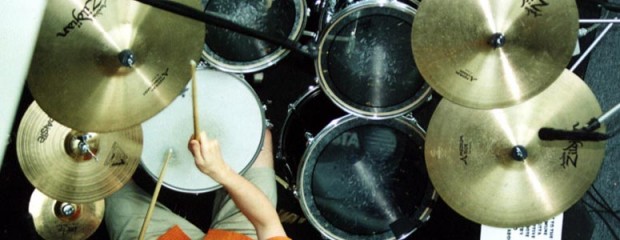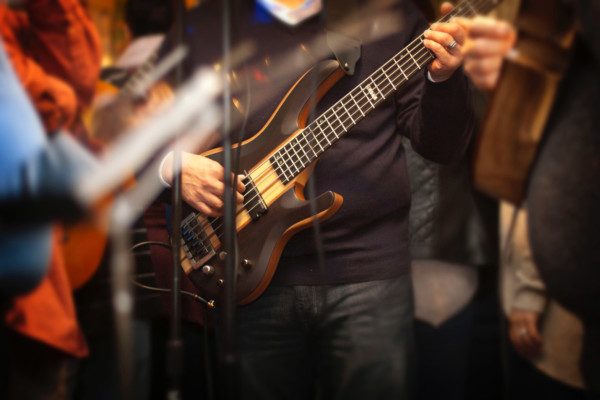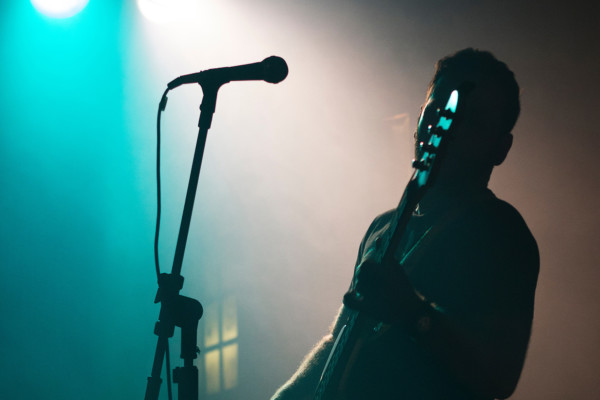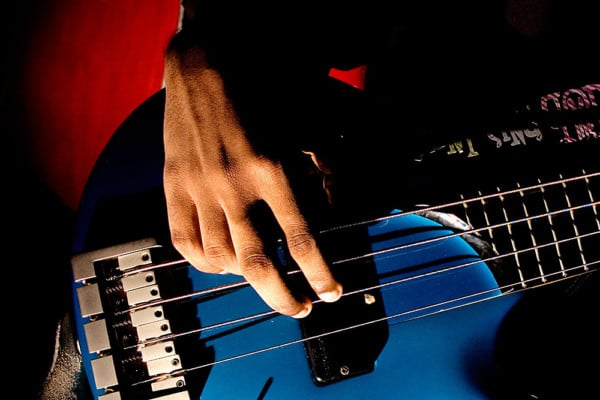Play Other Instruments! Such as… Drums

This installment of “other instruments” takes a look at playing the drums. Yes, they are fun. Yes, you can play loud and beat on things with sticks. No, you won’t have to fall victim to the jokes.
On a more serious note, the attention paid to rhythm and feel is one and the same while playing bass. Plus, within an ensemble, drums and bass work hand-in-hand to establish the musical bed for melody and harmony. Whether you’re trying to communicate with other musicians, looking for a different perspective on rhythm, or experimenting with your time keeping ability, getting comfortable behind a drum kit can be your secret musical weapon.
If you’ve ever sat down at the drums, the first thing you probably tried to play is a basic rock beat. Kick on 1 and 3, snare on 2 and 4, eighth notes on the hi-hat or ride, and the occasional fill. While this may seem fairly rudimentary, knowing which part of the kit accents certain beats can be a huge asset when it comes to playing bass. First, it gives you a framework to fit into… emphasize the downbeat with the kick drum, feel the backbeat of the snare, and recognize the metronomic subdivision on the cymbal. Second, it allows you to focus on what other drummers are doing… if they have a particularly strong or weak snare hit, if they don’t swing enough on a ride cymbal, or if they have an inconsistent kick drum pattern. And third, it gives you a better idea of how dynamics around a drum kit work. You can identify different parts or feels by noticing a change from the ride to the hi-hat, the slightly open vs. tightly closed hi-hat, or the cross stick vs. full hit on a snare. By sitting down at the set and personally experiencing how these changes impact a song, you’ll get a new perspective on the drummer’s control and relationship to the rest of the band (and especially to the bass player).
That said, playing drums at jam sessions happens to be one of my musical guilty pleasures… not only because it’s fun to change things up but because I want that difference in perspective. Suddenly, instead of worrying about which note to hit or figuring out the chord progression, I’m completely zoned in on keeping time. The musical priorities get rearranged, and although it’s important to play the right parts of the kit at the right time, it’s more important to keep the band together and maintain the integrity of the song and tempo. Intricate fills, quotes, and demonstrations of technique are stripped away and replaced by trying to groove on a different instrument. This acute attention to time and feel is something that I take for granted as a bass player, so it’s nice to step out of my comfort zone and be reminded of what other instrumentalists focus on. If you get the opportunity to play drums, and particularly to play along with others, take a moment to relish the difference in perspective.
Finally, having the ability to play drums can come in handy even when we’re not the ones sitting behind the kit. This is where communication comes into play… if we can speak the language of the instrument, we can describe to other players what we envision (a useful skill in jamming or composing). It’s great to be able to play different grooves, but since you’ll probably be playing bass in most situations, you’ll want to have the ability to verbally communicate these grooves.
Imagine yourself on a gig or at a jam, trying to play a new tune that the drummer’s never heard. Chances are, the singer won’t be able to describe the feel of the tune to the drummer, but you, fellow rhythm section player, should be able to. If you’ve had some experience playing drums, you’ll be able to label and recall different feels and, hopefully, relay the information. You don’t need to mention specifics, but simply stating whether something is a straight time groove, a swing, a “four on the floor,” or a medium shuffle can be a huge help. If there’s a specific drum groove that you’re familiar with, such as the “Purdie Shuffle” or “Bo Diddly” beat, you’ll be able to pass on that information without the aid of air-drumming.
While I don’t advise monopolizing the drum room at Guitar Center for your practice time, I certainly do suggest sitting down at a friend’s set once in a while, or investing in your own. Drums happened to be my “gateway instrument” before transitioning to bass, and I wouldn’t have had it any other way. It helped me establish a “rhythm section mindset” and drew my attention to keeping time and creating a feel. Now, having that skill is invaluable, particularly in songwriting and determining parts.
So, whenever you get a chance, play other instruments! Like… drums.
How about you? What have you discovered through picking up other instruments? Which ones have you tried? Tell us about it in the comments.
Photo by Andrew Rothman.
Ryan Madora is a professional bass player, author, and educator living in Nashville, TN. In addition to touring and session work, she teaches private lessons and masterclasses to students of all levels. Visit her website to learn more!




You could get good used drum kits from craigslist and similar places between $150-$300. Usually the skins are bad but it’s good to replace them, anyway. Same with cymbals, start with the crappy ones and upgrade later if needed. Drumming is fun!
Good article. Anything to help getting better acquainted with rhythm is always welcome.
these are amazing articles.
i have a feeling you want to learn how to play the drums